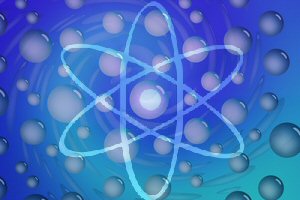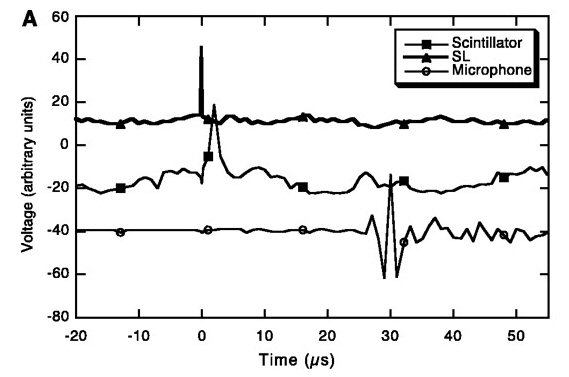ORNL Nuclear Cavitation – Surprise in Shapira-Saltmarsh Raw Data (Part 5)

Oak Ridge Nuclear Cavitation Confirmation
July 22, 2013 – By Steven B. Krivit –
This is Part 5 of “2001 Oak Ridge Nuclear Cavitation Confirmation Uncovered.”
This is a New Energy Times Special Report. The first part of this series published on July 18, 2013.
A Surprise in Shapira and Saltmarsh’s Raw Data (December 2001)
The conflict between the Taleyarkhan group and Shapira and Saltmarsh had been going on for six months.
In December 2002, Taleyarkhan thought to look at Shapira and Saltmarsh’s raw data.
“We were going back and forth with Shapira and Saltmarsh and the ORNL administration,” Taleyarkhan wrote. “The July Shapira and Saltmarsh reports were being circulated around. But on my close examination, I saw that their neutron-gamma curves for cavitation-on appeared to be higher than for cavitation-off. It occurred to me to ask to view their raw data.”
Shapira sent the raw data, and when the Taleyarkhan group did the analysis, it found that the Shapira and Saltmarsh raw data confirmed, rather than disconfirmed, the experiment. The data showed a statistically significant excess of neutrons during the one-hour test run that Shapira witnessed with cavitation in chilled deuterated acetone.
“Only after we analyzed it and we found this stunning result, did we confront Shapira and Saltmarsh with the information,” Taleyarkhan wrote. “I wrote to Shapira, and he thereafter went back, re-analyzed the spectra, and confirmed his new analysis to me. As he wrote in his Dec. 20, 2001, e-mail, Shapira’s data do indeed show a statistically significant increase of emissions — something he admitted in writing only after we reviewed his raw data.”
At first, as Shapira says in an e-mail, he sent some numbers to Taleyarkhan in the morning of Dec. 20 and, at the time, told Taleyarkhan that he came up with different numbers than those the Taleyarkhan group had found. Later that evening, Shapira took another look.
“When I got back,” Shapira wrote, “I started looking at the data much more closely and discovered that the numbers I sent this morning were computed on the wrong spectrum … so, with a shaking heart, I went on to calculate the ratios with method 1 and method 2, and thank goodness I did not make another mistake this morning. Wow! The numbers below are with the correct spectrum, and they agree with yours, I hope.”
Taleyarkhan wrote back to Shapira the next day.
“Dan, thank you for the honesty,” Taleyarkhan wrote. “We all make arithmetic mistakes and overlook things. At least you are ethical enough to accept. I did notice that the values you came up with [are] a bit different from mine, but I let it ride since, unlike the factor of 1.13 versus the 1.077 that you came up with previously, which completely negates everything, we [are] now just quibbling about a tiny difference that could be due to the way in which you do the summing starting with a different bin [number]. I just let [this minor difference] pass since we have one more area to [resolve] with you. Let’s now do the same and come to terms for the coincidence crap we’re in.”
Taleyarkhan wanted to work with Shapira to resolve their disagreement about the coincidences issue.
Now, both groups’ neutron singles counts confirmed the Taleyarkhan group’s claim.
Shapira Concedes Neutrons (December 2001)
In response to the newly revealed data from his own detector, Shapira wrote a new internal document of the Taleyarkhan draft paper. Shapira’s review, “Review of Second SL Manuscript,” dated Dec. 19, 2011, acknowledged the positive neutron singles data, as well as the positive tritium data that had been confirmed by Murray.
“The paper presents a convincing case of excess tritium productions when cavitation is induced in cold deuterated acetone,” Shapira wrote. “The methods and procedures in collecting these data have been independently reviewed by a relevant ORNL expert in the field.”
“The [Taleyarkhan group’s] paper also presents data which show excess of nuclear radiation (neutrons/gammas) production when cavitation is induced in deuterated acetone,” Shapira wrote.
With an expert’s confirmation of the tritium data and the neutron singles data, the confidence of ORNL management grew.
“After Shapira’s admission of his error with the neutron counts that he measured with his own detector,” Taleyarkhan wrote, “the scenario with ORNL management changed. They realized that the Shapira and Saltmarsh measurements were also showing support for the essence of our claim: nuclear emissions with cavitation on versus off.”
But Shapira’s concession came with a twist.
In Shapira’s document, after he confirmed the neutron singles and tritium, he reintroduced the coincidence demand that he had made back in the summer with his and Saltmarsh’s July 2001 internal reports.
“The authors should point out, in their [forthcoming Science] paper, that a proper coincidence experiment, which tries to associate the nuclear radiation with light coming from the bubble collapse, which occurs about 60 microseconds after the pulsed neutron generator burst, is needed for further proof of their assertion/model,” Shapira wrote.
It is not clear how many sets of coincidences Shapira and Saltmarsh demanded for satisfactory proof, but the Taleyarkhan group was able to show some. The figure below is from the Taleyarkhan group’s Science paper and shows the coincidence between the nuclear radiation (Scintillator) and the (SL) light flash from the bubble collapse, followed by the acoustic shock wave. The scintillator and SL flash signals occur within several nanoseconds.

Representative time sample showing signal of SL flash, the scintillator nuclear signal, and microphone shock trace signals (C3D6O cavitation experiments at 0 degrees C). (Science 2002)
ORNL Conflict Continues (January 2002)
However, some ORNL administrators still thought that Shapira and Saltmarsh’s concern was valid.
“Regardless,” Taleyarkhan wrote, “Shapira, Saltmarsh and Roberto had solidified their negative positions about our claim, and it appeared that they had conveyed their opinions externally, including to staff at the Department of Energy.”
On Jan 28, 2002, Shapira wrote another internal document, “Evaluation of Discrepancy Between Coincidence Measurements Performed by P.D. And E.T.D.”
By this time, even though he had conceded that the tritium was real, and that both the Engineering Technology Division detector and the Physics Division detectors confirmed the excess neutrons, he was still trying, in this paper, to dispute the claim, using his demand for coincidence measurements.
In the quote below, Shapira’s comment about a “PD experiment” is the first time he implies that the pair of one-hour runs of the Taleyarkhan group’s experiment, in the Taleyarkhan group’s lab, when he measured neutrons, was Shapira’s (PD’s) experiment.
“Both [ETD and PD] experiments agree as far as the existence of enhancement in the [neutron] singles data,” Shapira wrote. “The enhancement seen in the singles neutron-gamma counts when cavitation is turned on is observed in both [sets of] experiment[s.]”
“With regard to the coincidence data, the two measurements completely disagree,” he wrote.
“In the PD experiment, we DO SEE an increase in the coincidence rate when we turn on cavitation,” Shapira wrote. “A careful examination of the time distribution of coincidence, neutron-gamma singles and light signals during the time duration between PNG pulses was carried out in the same experiment.
“The data show that the coincidences seen when cavitation is turned on are due to random coincidences between light signals and nuclear radiation (neutron-gamma). With cavitation turned off, the coincidence rate decreases dramatically, but also the expected random rate is near zero because there are almost no light signals detected after the PNG pulse subsides.”
In this document, Shapira wrote that, during the July 24, 2001, run in which he took data from the Taleyarkhan group’s experiment (which he calls the “PD experiment”), he saw coincidences. But he came up with an explanation for the coincidences appearing only when cavitation is on: an undefined random phenomenon. This was the first alternative hypothesis that Shapira proposed.
In the paper, Shapira’s conclusion is very confusing and seems to have some logic gaps. The emphasis is his.
“At present, I do not find any reason to discard the results of the coincidence experiment done with the PD detector. I cannot see any reason why we should not have seen the same coincidences seen with the ETD detector. This leaves only the last explanation for the discrepancy: The coincidences that they see in the ETD experiment OCCUR DURING THE TIME THAT THE NEUTRON GENERATOR FIRES.”
Despite Shapira’s emphatic conclusion, his thesis is contradicted by the control experiments during which the neutron generator also fires.
Next Part: Science Accepts Nuclear Cavitation Paper
Questions? Comments? Submit a Letter to the Editor.

